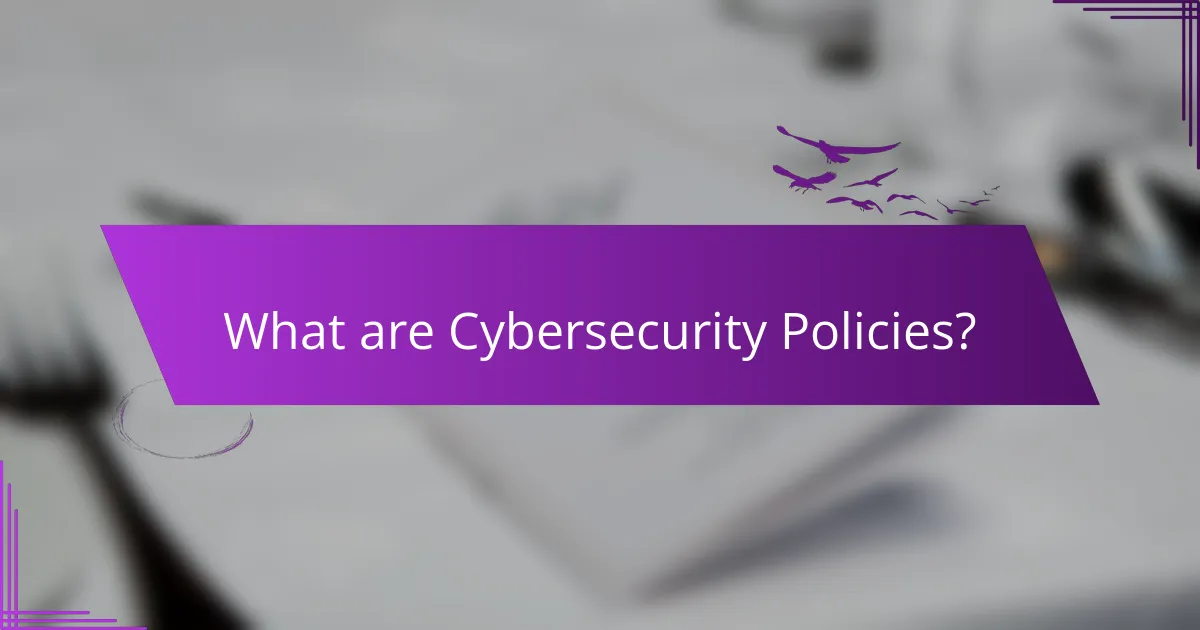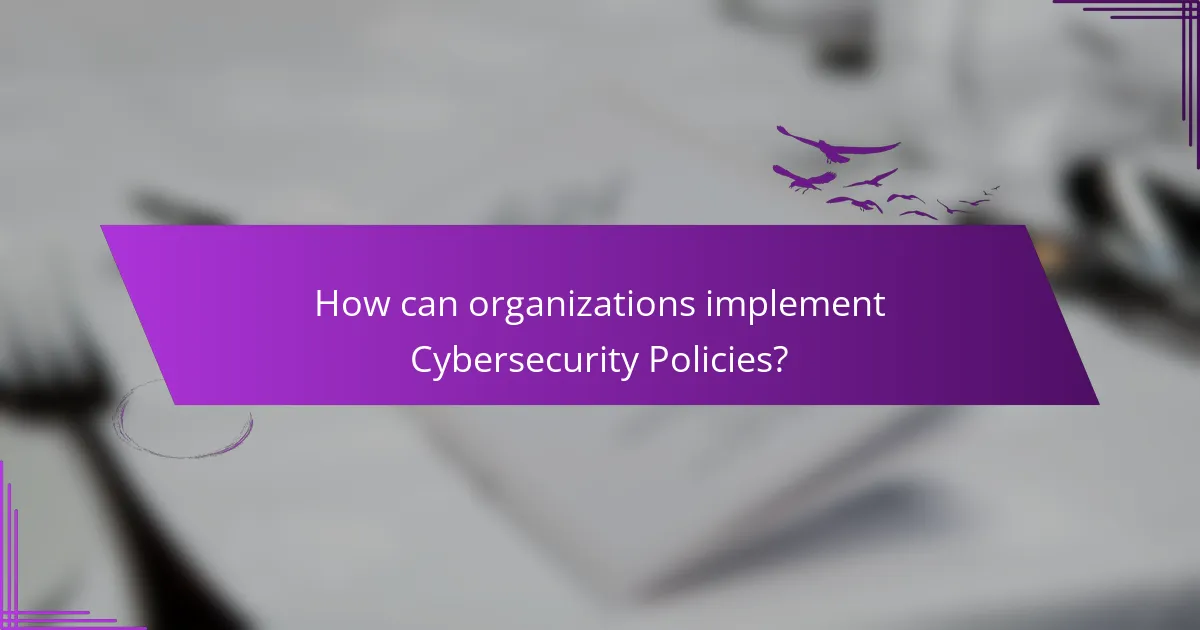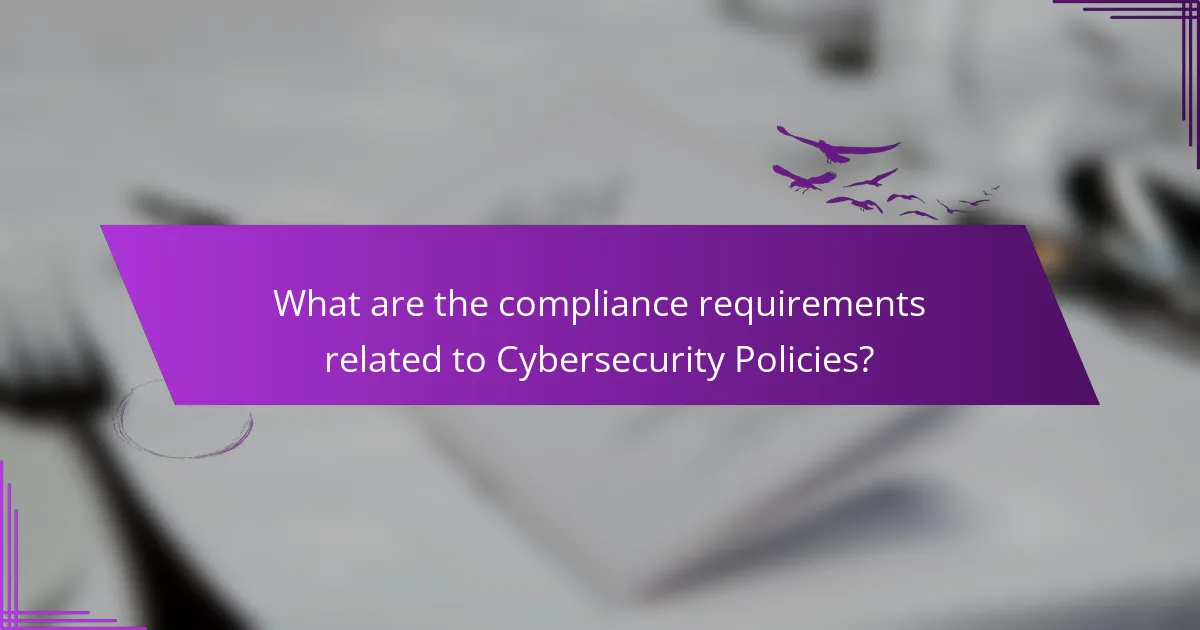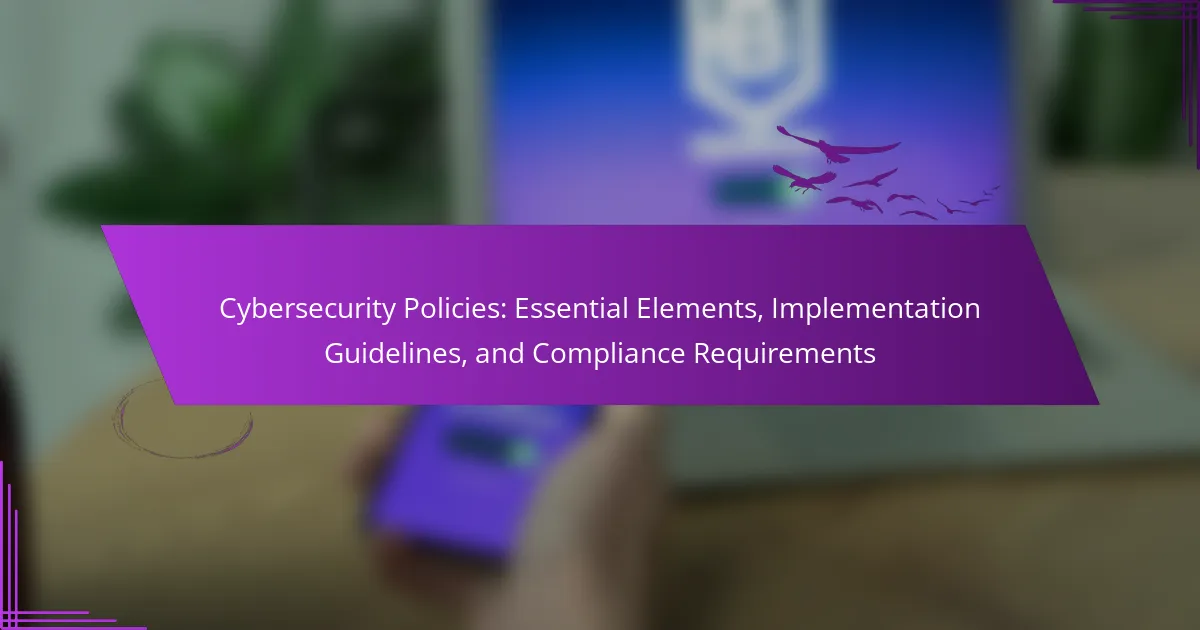
What are Cybersecurity Policies?
Cybersecurity policies are formalized guidelines that dictate how an organization manages its cybersecurity efforts. These policies outline the rules and procedures for protecting sensitive information and systems. They serve to mitigate risks associated with cyber threats. Organizations implement these policies to ensure compliance with legal and regulatory requirements. Effective cybersecurity policies typically cover areas such as data protection, user access controls, and incident response protocols. By establishing clear expectations, these policies help employees understand their roles in maintaining security. Research indicates that organizations with well-defined cybersecurity policies experience fewer breaches and improved incident response times.
Why are Cybersecurity Policies important for organizations?
Cybersecurity policies are crucial for organizations to establish a framework for protecting sensitive information. They define acceptable behaviors and outline procedures for responding to security incidents. These policies help mitigate risks associated with data breaches and cyberattacks. According to a report by IBM, the average cost of a data breach in 2023 was $4.45 million. This emphasizes the financial impact of inadequate cybersecurity measures. Additionally, well-defined policies ensure compliance with regulatory requirements, such as GDPR and HIPAA. This compliance reduces the risk of legal penalties and enhances organizational reputation. Overall, cybersecurity policies are essential for safeguarding assets and maintaining trust with stakeholders.
What risks do Cybersecurity Policies mitigate?
Cybersecurity policies mitigate risks such as data breaches, unauthorized access, and malware attacks. They establish guidelines that protect sensitive information. These policies help organizations comply with regulations. Compliance reduces legal risks and financial penalties. Cybersecurity policies also address insider threats and social engineering attacks. They promote employee awareness and training. Effective policies can significantly lower the risk of cyber incidents. Statistics show that organizations with formal policies experience fewer security breaches.
How do Cybersecurity Policies protect sensitive information?
Cybersecurity policies protect sensitive information by establishing guidelines for data security practices. These policies define roles and responsibilities regarding data protection. They include protocols for data encryption, access controls, and incident response. Regular training and awareness programs are mandated to ensure compliance. Monitoring and auditing processes are implemented to detect breaches. According to the Ponemon Institute, organizations with formal cybersecurity policies experience 50% fewer security incidents. This demonstrates the effectiveness of structured policies in safeguarding sensitive data.
What are the key components of effective Cybersecurity Policies?
Key components of effective cybersecurity policies include risk assessment, incident response, and employee training. Risk assessment identifies vulnerabilities and threats to the organization. Incident response outlines procedures for managing and mitigating security breaches. Employee training ensures staff understand security protocols and best practices. Access controls restrict unauthorized access to sensitive information. Compliance with legal and regulatory standards is essential for maintaining security. Regular policy reviews and updates keep the cybersecurity framework relevant. Documentation of policies provides clear guidelines for all stakeholders. These components collectively enhance an organization’s cybersecurity posture.
What elements should be included in a Cybersecurity Policy?
A Cybersecurity Policy should include the following elements: purpose and scope, roles and responsibilities, data classification, acceptable use policy, access control measures, incident response plan, and compliance requirements. The purpose and scope define the policy’s intent and applicability across the organization. Roles and responsibilities outline who is accountable for various security tasks. Data classification specifies how different types of data should be handled based on their sensitivity. An acceptable use policy details the proper use of organizational resources and technology. Access control measures establish how access to systems and data is granted and managed. The incident response plan outlines procedures for managing security breaches. Compliance requirements ensure adherence to relevant laws and regulations, such as GDPR or HIPAA. Each of these elements plays a crucial role in establishing a comprehensive cybersecurity framework for organizations.
How do these components contribute to overall cybersecurity posture?
Components such as risk assessment, incident response, and security training significantly enhance overall cybersecurity posture. Risk assessment identifies vulnerabilities and threats, allowing organizations to prioritize their defenses. Incident response plans ensure quick recovery from breaches, minimizing damage and downtime. Security training educates employees on recognizing threats, reducing the likelihood of human error. Together, these elements create a proactive security environment. According to a 2021 study by the Ponemon Institute, organizations with comprehensive cybersecurity training programs experienced 50% fewer security incidents. Thus, these components are critical in establishing a robust cybersecurity framework.

How can organizations implement Cybersecurity Policies?
Organizations can implement Cybersecurity Policies by following a structured approach. First, they should assess their current security posture. This involves identifying vulnerabilities and potential threats. Next, organizations must define clear security objectives and goals. These objectives should align with business needs and regulatory requirements.
After defining objectives, organizations should develop comprehensive policies. These policies must address areas such as data protection, access control, and incident response. It is essential to involve stakeholders in the policy development process. This ensures that the policies are practical and widely accepted.
Once policies are developed, organizations should provide training to employees. This training ensures that all staff understand their roles in maintaining cybersecurity. Regular updates and reviews of the policies are necessary. This keeps the policies relevant and effective against evolving threats.
Finally, organizations should implement monitoring and enforcement mechanisms. This ensures compliance with the established policies. Regular audits can help identify gaps and areas for improvement. This structured approach leads to a robust implementation of cybersecurity policies.
What steps are involved in the implementation process?
The implementation process involves several key steps. First, organizations must define their cybersecurity objectives and scope. This includes identifying specific risks and compliance requirements. Next, they should develop a detailed implementation plan. This plan outlines tasks, timelines, and responsible parties.
Following this, organizations need to allocate resources effectively. This includes budgeting for technology and personnel training. Once resources are in place, organizations should deploy the necessary technologies and tools. This can involve installing software and configuring systems.
After deployment, it is crucial to conduct training for all employees. This ensures that staff understands their roles in maintaining cybersecurity. Finally, organizations must establish a monitoring and evaluation framework. This allows for ongoing assessment of the effectiveness of the cybersecurity measures implemented.
How can organizations assess their current cybersecurity posture?
Organizations can assess their current cybersecurity posture through a combination of audits, assessments, and testing. They should start with a comprehensive risk assessment to identify vulnerabilities. This involves evaluating existing security controls and policies. Organizations can utilize frameworks such as NIST Cybersecurity Framework or ISO 27001 for guidance. Regular [censured] testing helps identify weaknesses in systems. Additionally, conducting employee training enhances awareness of security practices. Continuous monitoring of networks and systems ensures real-time threat detection. According to a 2021 study by Cybersecurity Insiders, 79% of organizations reported that regular assessments improved their security posture.
What role does employee training play in implementation?
Employee training is crucial for the successful implementation of cybersecurity policies. Training equips employees with the necessary knowledge and skills to recognize potential threats. It fosters a culture of security awareness within the organization. Employees trained in cybersecurity can effectively follow protocols and respond to incidents. According to a study by the Ponemon Institute, organizations with security awareness programs can reduce the risk of data breaches by up to 70%. Regular training updates ensure that employees stay informed about evolving threats and compliance requirements. Thus, employee training significantly enhances the overall effectiveness of cybersecurity measures during implementation.
What challenges might organizations face during implementation?
Organizations may face several challenges during the implementation of cybersecurity policies. Resistance to change is common among employees, as they may be accustomed to existing practices. Limited resources can hinder the ability to effectively implement new policies. Additionally, lack of training can lead to misunderstandings and improper application of cybersecurity measures. Compliance with legal and regulatory requirements can also pose difficulties, as organizations must stay updated on evolving standards. Insufficient communication can result in a lack of awareness about the policies among staff. Furthermore, integrating new technologies with existing systems can create technical challenges. Finally, measuring the effectiveness of implemented policies can be complex, making it hard to assess their impact.
How can organizations overcome resistance to policy changes?
Organizations can overcome resistance to policy changes by engaging employees in the change process. Communication is key; clearly explaining the reasons for the policy changes helps build understanding. Involving employees in discussions can address concerns and gather valuable feedback. Training sessions can equip staff with the necessary skills to adapt to new policies. Leadership support reinforces the importance of the changes. Providing incentives can motivate employees to embrace new policies. Monitoring the implementation can identify areas of resistance and allow for adjustments. Research shows that organizations with strong change management strategies see higher employee buy-in and lower resistance rates.
What resources are available to assist with implementation?
Resources available to assist with implementation include frameworks, guidelines, and tools. The NIST Cybersecurity Framework provides a comprehensive approach to managing cybersecurity risks. The ISO/IEC 27001 standard offers guidelines for establishing, implementing, and maintaining an information security management system. Online training platforms, such as Coursera and Udemy, provide courses on cybersecurity policy implementation. Government agencies, like the Cybersecurity and Infrastructure Security Agency (CISA), offer resources and best practices. Additionally, cybersecurity consulting firms can provide tailored support and expertise. These resources are designed to enhance the effectiveness of cybersecurity policies and ensure compliance with regulations.

What are the compliance requirements related to Cybersecurity Policies?
Compliance requirements related to Cybersecurity Policies include adherence to various regulations and standards. Organizations must comply with frameworks such as NIST, ISO 27001, and GDPR. These frameworks outline specific security controls and practices. Regular risk assessments are required to identify vulnerabilities. Documentation of policies and procedures is essential for compliance. Training and awareness programs for employees must be implemented. Incident response plans are necessary to address potential breaches. Audits and assessments should be conducted periodically to ensure compliance.
What regulations govern Cybersecurity Policies?
Regulations that govern cybersecurity policies include the General Data Protection Regulation (GDPR), the Health Insurance Portability and Accountability Act (HIPAA), and the Federal Information Security Management Act (FISMA). The GDPR mandates data protection and privacy for individuals within the European Union. HIPAA sets standards for protecting sensitive patient health information in the United States. FISMA requires federal agencies to secure information systems and establish a framework for cybersecurity. Additionally, the Payment Card Industry Data Security Standard (PCI DSS) governs the security of credit card transactions. These regulations ensure organizations implement necessary cybersecurity measures to protect data and maintain compliance.
How do organizations ensure compliance with these regulations?
Organizations ensure compliance with cybersecurity regulations by implementing structured policies and practices. They conduct regular risk assessments to identify vulnerabilities. Training employees on security protocols is essential to maintain awareness. Organizations also utilize monitoring tools to detect and respond to incidents. Regular audits help assess compliance with regulations. They may engage third-party assessments for an objective review. Documentation of policies and procedures is crucial for accountability. These steps collectively help organizations meet regulatory requirements effectively.
What are the consequences of non-compliance?
The consequences of non-compliance with cybersecurity policies include legal penalties, financial losses, and reputational damage. Organizations may face fines imposed by regulatory bodies for failing to adhere to established standards. For example, the General Data Protection Regulation (GDPR) can result in penalties up to 4% of annual global turnover. Financial losses can arise from data breaches, which cost an average of $3.86 million per incident, according to IBM. Additionally, non-compliance can lead to loss of customer trust, negatively impacting business relationships and future revenue. Companies may also experience increased scrutiny from regulators and stakeholders.
How can organizations stay updated on compliance requirements?
Organizations can stay updated on compliance requirements by regularly monitoring regulatory changes. They should subscribe to relevant industry newsletters and alerts. Engaging with professional associations can provide access to updates and best practices. Participating in compliance training and workshops enhances understanding of requirements. Utilizing compliance management software can streamline tracking of changes. Implementing a compliance calendar helps organizations stay organized with deadlines. Consulting legal experts ensures clarity on complex regulations. Regular audits help identify compliance gaps and areas for improvement.
What resources can help organizations track changes in regulations?
Organizations can track changes in regulations through several resources. Regulatory compliance software is a primary tool that automates updates on legal changes. Services like LexisNexis and Westlaw provide comprehensive legal research databases. These platforms offer alerts for new regulations relevant to specific industries. Professional associations often publish newsletters that summarize regulatory updates. Government websites frequently post changes in laws and regulations. Consulting firms also provide insights and analysis on regulatory developments. Additionally, webinars and industry conferences can offer valuable information on compliance trends.
How often should Cybersecurity Policies be reviewed for compliance?
Cybersecurity policies should be reviewed for compliance at least annually. This regular review helps ensure that the policies remain effective and relevant. Additionally, any significant changes in the organization or regulatory environment may necessitate more frequent reviews. For instance, if there is a major security incident, the policies should be reassessed immediately. Regular audits and assessments can also identify areas needing updates. Keeping policies aligned with industry standards is crucial for compliance. Organizations often face evolving threats, making timely reviews essential for effective cybersecurity management.
What best practices should organizations follow for Cybersecurity Policies?
Organizations should establish comprehensive cybersecurity policies that are regularly updated. These policies must clearly define user roles and responsibilities regarding data protection. Regular training sessions for employees on cybersecurity awareness are essential. Implementing multi-factor authentication enhances access security significantly. Regular audits and assessments of security measures ensure compliance and effectiveness. Organizations should also establish incident response plans to address potential breaches swiftly. Monitoring network activity can help identify and mitigate threats in real-time. Collaborating with legal and compliance teams ensures alignment with regulations and standards.
How can organizations create a culture of cybersecurity awareness?
Organizations can create a culture of cybersecurity awareness by implementing comprehensive training programs. These programs should educate employees on potential threats and safe online practices. Regular workshops and seminars can reinforce knowledge and keep employees updated on new threats. Leadership must actively promote cybersecurity as a priority. Clear communication about policies and expectations is essential. Encouraging reporting of suspicious activities fosters a proactive environment. Gamification of training can enhance engagement and retention of information. Research shows that organizations with strong cybersecurity training see a significant reduction in incidents. For example, a study by the Ponemon Institute found that companies with effective training programs reduce the likelihood of breaches by up to 70%.
What common pitfalls should organizations avoid when developing policies?
Organizations should avoid several common pitfalls when developing policies. First, they should not overlook stakeholder involvement. Engaging relevant stakeholders ensures diverse perspectives are considered. Second, organizations should avoid vague language. Clear and precise wording helps prevent misinterpretation. Third, insufficient training is a common mistake. Employees must understand policies for effective implementation. Fourth, failing to review and update policies regularly can lead to obsolescence. Cyber threats evolve, and policies must adapt accordingly. Fifth, organizations should avoid a one-size-fits-all approach. Tailoring policies to specific organizational needs enhances effectiveness. Lastly, neglecting to communicate policies effectively can result in non-compliance. Consistent communication reinforces understanding and adherence among employees.
Cybersecurity policies are formalized guidelines that govern how organizations manage their cybersecurity efforts, protecting sensitive information and systems from cyber threats. This article outlines the importance of these policies, their key components, and the steps necessary for effective implementation, including compliance with regulatory requirements such as GDPR and HIPAA. It also addresses the risks mitigated by these policies, the role of employee training, and best practices for fostering a culture of cybersecurity awareness. Additionally, the article discusses the challenges organizations may face during implementation and the resources available to assist in developing robust cybersecurity frameworks.
